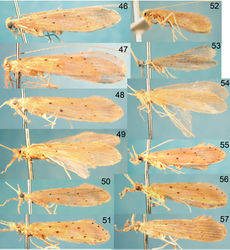Oecetis maritza
| Notice: | This page is derived from the original publication listed below, whose author(s) should always be credited. Further contributors may edit and improve the content of this page and, consequently, need to be credited as well (see page history). Any assessment of factual correctness requires a careful review of the original article as well as of subsequent contributions.
If you are uncertain whether your planned contribution is correct or not, we suggest that you use the associated discussion page instead of editing the page directly. This page should be cited as follows (rationale):
Citation formats to copy and paste
BibTeX: @article{Blahnik2014ZooKeys376, RIS/ Endnote: TY - JOUR Wikipedia/ Citizendium: <ref name="Blahnik2014ZooKeys376">{{Citation See also the citation download page at the journal. |
Ordo: Trichoptera
Familia: Leptoceridae
Genus: Oecetis
Name
Oecetis maritza Blahnik & Holzenthal, 2014 sp. n. – Wikispecies link – ZooBank link – Pensoft Profile
Diagnosis
Oecetis maritza is most similar to Oecetis mexicana sp. n., especially in the general form of the genitalia, with the ventral lobe obtusely angled (or forming a nearly right angle with the dorsal lobe), and in the general shape of the phallobase, with the ventral margin arched and apex U-shaped in caudal view. It is most easily distinguished by its smaller size and darker coloration (compare Figs 50 and 53). There are several minor genitalic differences. The dorsal lobe of the inferior appendage is relatively narrow throughout, and an asymmetrical phallic sclerite seems to be absent. In the shape of the dorsal lobe of the inferior appendage and absence of an asymmetrical phallic sclerite, Oecetis maritza resembles Oecetis patula sp. n. The latter differs in its larger size, light yellowish color, and especially in having the apex of the phallobase very broad in caudal view. Although Oecetis maritza is known from only 2 specimens (1 with the genitalia lost after being examined and illustrated), they are different enough from Oecetis mexicana, which also occurs in Costa Rica, to warrant their recognition as a distinct species.
Adult
Forewing length: male (6.0 mm). Color yellowish-brown (darker than Oecetis mexicana sp. n.). Antennae whitish with indistinct, narrow annulations at intersection of antennomeres. Forewing spots small, brown, distinct, but not strongly contrasting with overall color of wing, spots at base discal and thyridial cells and base of fork V largest; veins of forewing chord very widely, almost evenly, spaced; chord pigmented; apical spots present, but not conspicuous. Setae on forewing membranes short, scant, decumbent, setae along veins in apical part of forewing semi-prostrate, laterally diverging. Fringe of setae along costal margin of forewing dense, very elongate, distinctly projecting.
Male genitalia
Segment IX very short, with elongate setae along posterolateral margin. Tergum X with narrow, deflexed mesal lobe, lobe more or less uniform in width, narrowing apically, with small sensilla; lobe continuous basoventrally with projecting lateral membranous projections. Preanal appendage moderately elongate, length about 3 times maximum width, simple in structure, apical setae elongate. Inferior appendage with dorsal lobe narrow, uniform in width, rounded apically, ventral lobe angularly projecting; projection of ventral lobe forming obtuse angle with dorsal lobe; posterior margin of ventral lobe, as viewed ventrally (Fig. 15F), angularly bent near base, apices of paired lobes moderately diverging; basomesal projection of appendage very weakly developed, scarcely projecting, with several short, stiff setae; dorsal lobe with slightly thickened, mesally-curved setae on dorsal margin and stout, ventrally-curved setae on mesal surface. Phallobase relatively short; as viewed laterally, expanded apically, ventral margin distinctly arched, apex acute; as viewed ventrally, bulbously rounded in middle; ventral apex, as viewed caudally, U-shaped. Phallotremal sclerite prominent, tubular basally, ventral margin projecting, gradually narrowed, acute apically; asymmetrical lateral sclerite absent.
Holotype
Male (pinned), COSTA RICA: Guanacaste: Parque Nacional Guanacaste, Estación Maritza, Río Tempisquito, 10°57.480'N, 85°29.820'W, 550 m, 13–15.vii.1992, F. Muñoz (UMSP) (INBIOCRI000513479).
Paratypes
COSTA RICA: Guanacaste: Parque Nacional Guanacaste, Estación Patilla, Río Orosi, 10°59.460'N, 85°25.460'W, 700 m, 22-25.v.1990, Holzenthal & Blahnik, 1 male (pinned, missing genitalia) (UMSP).
Etymology
This species is named Oecetis maritza, the name used as a noun in apposition, for Estación Maritza in Guanacaste National Park, where the type specimen was collected.
Original Description
- Blahnik, R; Holzenthal, R; 2014: Review and redescription of species in the Oecetis avara group, with the description of 15 new species (Trichoptera, Leptoceridae) ZooKeys, 376: 1-83. doi
Images
|

